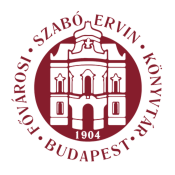Szatmári Gizella: Signs of Remembrance - Our Budapest (Budapest, 2005)
The Expert Researcher of Pannónia and Dacia The physiognomy of the man who founded the Capital City Museum is preserved by a plaque on the wall of the Museum of Aquincum (139 Szentendrei út, District III) made by József Ispánki in 1944. The date marked the eightieth anniversary of Bálint Kuzsinszky's birth. As it is to be expected in the case of an archaeologist who devoted most of his working life to the excavation and preservation of the Roman finds at Aquincum, the language of the inscription is Latin. (... QU1 PLURIMA AQU1NC1 MONUMENTA DIEI IN LUMEN REDDIDIT..., in a somewhat free rendering: ...innumerable relics of the daily life of Aquincum were recovered with his help...) Having begun his academic career as the assistant of Károly Toma in 1887, the following year Kuzsinszky was already in charge of the excavations. The finds of the digs he worked on were exhibited in the Krempel Mill of Óbuda. Out of the exhibition grew the Archaeological Museum of Budapest, which was to collect and exhibit the Roman finds excavated during the large-scale construction projects — e.g. the reconstruction of the Royal Palace in the Buda Castle, the building of the Elizabeth Bridge — carried out in the nationwide preparations for the Millenary Celebrations. The building of the museum was designed by Gyula Orczy, who followed Roman models of architecture. There is a colonnaded portico here and, built into the plinth, are altar-stones once set up to honour Roman deities. The ceremonial hall was reminiscent of Pompeiian murals. Fragments of paintings and small objects were also on show. "The bronze fittings of a small toilet-box unearthed from a grave has been well preserved ... there was a spool, a wooden bracelet and a bone comb lying next to it; the fragmented lettering adds up to the inscription: Utere feliciter — use it in all happiness,” recounted József Révay. Epigraphy was a discipline Kuzsinszky was particularly fond of. In his lectures at the Department of Ancient History after his appointment to the faculty there (1901), he concentrated on the discussion of finds of Pannonian and Dacian origins in general and the examination of inscribed sources in particular. From 1914 to 1930 he worked at the Department of Numismatics and Archaeology. It was alongside these activities that he drafted, on a request made by the municipal board of Budapest, his detailed recommendations for the organisational framework and collection interest of a planned Capital City Museum. 69
